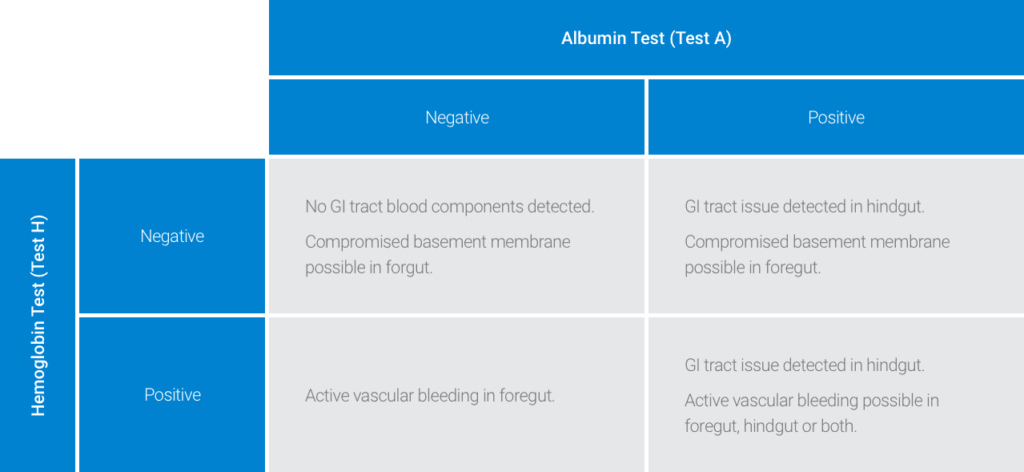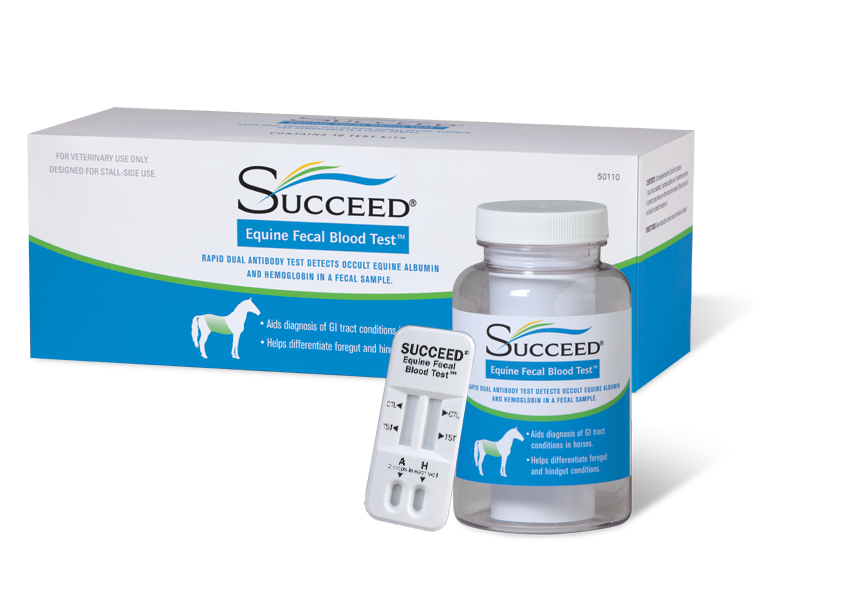Reading the results of a SUCCEED FBT is similar to reading a pregnancy test. A control line indicates that the test is working, and a second line – no matter how faint – indicates a positive result for either albumin or hemoglobin.
Observe results after applying the solution to each of the two sample wells on the cassette. Note: Do not read test results after 15 minutes.
- Positive – If both the Control and Test lines appear on either window (Test A or H), this indicates a POSITIVE test result. Even if the test line is faint, the test is POSITIVE.
- Negative – If only a control line appears on either strip, that test is NEGATIVE. NOTE: only a complete line is a meaningful result.
- Invalid – If a Control line does not appear within 15 minutes (at the CTL point on the cassette) that test result is invalid. The test must then be repeated with a new SUCCEED Equine Fecal Blood Test.
How to Interpret Positive and Negative FBT Results

- Negative A, Negative H = no GI tract issue detected.
- Positive A, Negative H = GI tract issue detected in hindgut.
- Negative A, Positive H = GI tract issue detected in foregut.
- Positive A, Positive H = GI tract issue in hindgut. Foregut issue also possible.
Test A
Note that Test A uses an antibody for albumin, which typically breaks down in digestion, particularly when exposed to digestive enzymes in the proximal portion of the small intestine relative to the common bile duct. Thus a positive Test A will indicate injury producing albumin at a location caudal to the duodenum. While such injury is most likely going to occur in the hindgut (particularly the colon), veterinarians should note that intestinal sources are still possible.
Also, because albumin may be present at the site of low-grade injury absent whole blood, a positive Test A may result from a low-grade lesion in the hindgut (i.e.,.a “weeping” lesion), such as may occur with heavy parasitism or disseminated grade 1 colonic ulcers.
Test H
Applying Results
While the SUCCEED FBT results are not difficult to interpret, understanding how they fit into a complete and accurate diagnosis requires the specialized knowledge of a veterinary practitioner. The results of the SUCCEED Equine Fecal Blood Test are just one helpful tool in your diagnostic arsenal, providing direction for what steps to take next.
Factors to Keep in Mind Throughout the Diagnostic Process
Subjective Information
- How do the horse’s symptoms and history point to a particular GI pathology, or set of pathologies?
- Does the horse present any of these clinical signs?
- Poor hair coat
- Acute weight loss, anorexia or inappetence
- Diarrhea or intermittent loose stools
- Resistance, lethargy, or poor behavior under saddle
- Girthiness, cribbing, or other stall vices
- Difficulty bending, collecting, or moving forward
- Does the horse’s current or past management include any of the following?
- Feeding concentrates
- Restricted turnout
- Large meals
- Hours between meals
- Traveling
- Competing
- Riding regularly
- All of these are potential signs of, or risk factors for, poor gut health.
Objective Data
The SUCCEED FBT is just part of an arsenal of objective diagnostic tools that can aid in evaluating potential GI conditions. Others include:
- Gastroscopy
- Fecal pH levels
- Bloodwork / CBC
- Ultrasound
Information provided using these and other objective methods can help to narrow the diagnosis after a positive FBT result.
NOTE: The FBT should not be used as a replacement for endoscopy, as it cannot detect grade 1 ulcers in a horse’s stomach. Additionally, while a positive for both albumin and hemoglobin indicates a definite hindgut issue, an accompanying gastric condition may also be present.
Assessment
All of the information gathered subjectively and objectively along with a positive FBT result can help narrow down potential diagnoses. Armed with this information, veterinarians can more accurately identify GI conditions such as:
- Gastric ulceration
- Colonic ulceration
- Enteritis
- Protein losing enteropathy (PLE)
- Parasitism
The FBT may also be used to monitor wellness as well as recovery after GI surgery.
Plan
Ask Us About a Free Trial
How to Purchase the SUCCEED® FBT
The SUCCEED FBT is available for purchase through your veterinary supply distributor.

Take the next steps toward achieving complete GI health.
Are you interested in continuing the conversation on how to achieve and maintain total digestive health in your clients’ horses? Let us know how we can help.
